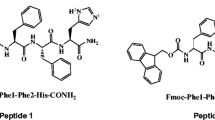Abstract
The 3D structure of the amidase from Rhodococcus erythropolis (EC 3.5.1.4) built by homology-based modeling is presented. Propionamide and acetamide are docked to the amidase. The reaction models were used to characterize the explicit enzymatic reaction. The calculated free energy barrier at B3LYP/6-31G* level of Model A (Ser194 + propionamide) is 19.72 kcal mol−1 in gas (6.47 kcal mol−1 in solution), and of Model B (Ser194 + Gly193 + propionamide) is 18.71 kcal mol−1 in gas (4.57 kcal mol−1 in solution). The docking results reveal that propionamide binds more strongly than acetamide due to the ethyl moiety of propionamide, which makes the carboxyl oxygen center of the substrate slightly more negative, making formation of the positively charged tetrahedral intermediate slightly easier. The quantum mechanics results demonstrate that Ser194 is essential for the acyl-intermediate, and Gly193 plays a secondary role in stabilizing acyl-intermediate formation as the NH groups of Ser194 and Gly193 form hydrogen bonds with the carbonyl oxygen of propionamide. The new structural and mechanistic insights gained from this computational study should be useful in elucidating the detailed structures and mechanisms of amidase and other homologous members of the amidase signature family.






Similar content being viewed by others
References
Hashimoto Y, Nishiyama M, Ikehata O, Horinouchi S, Beppu T (1990) Biochim Biophys Acta 1088:225–233
Mayaux JF, Cerbelaud E, Soubrier F, Faucher D, Petre D (1990) J Bacteriol 172:6764–6773
Skouloubris S, Labigne AH, Reuse HD (2001) Mol Microbiol 40:596–609, doi:10.1046/j.1365-2958.2001.02400.x
Vliet AHMV, Stoof J, Poppelaars SW, Bereswill S, Homuth G, Kist M et al (2003) J Biol Chem 278:9052–9057, doi:10.1074/jbc.M207542200
Patricelli MP, Cravatt BF (2000) J Biol Chem 275:19177–19184, doi:10.1074/jbc.M001607200
Shin S, Yun SY, Koo HM, Kim YS, Choi KY, Oh BH (2003) J Biol Chem 278:24937–24943, doi:10.1074/jbc.M302156200
Shin S, Lee TH, Ha NC, Koo HMS, Kim Y, Lee H-S et al (2002) EMBO J 21:2509–2516, doi:10.1093/emboj/21.11.2509
Labahn J, Neumann S, Buldt G, Kula MR, Granzin J (2002) J Mol Biol 322:1053–1106, doi:10.1016/S0022-2836(02)00886-0
Nakamura A, Yao M, Chimnaronk S, Sakai N, Tanaka I (2006) Science 312:1954–1968, doi:10.1126/science.1127156
Altschul SF, Madden TL, Schäfer AA, Zhang JZ, Miller DJ (1997) Nucleic Acids Res 25:3389–3402, doi:10.1093/nar/25.17.3389
Montgomerie S, Cruz JA, Shrivastava S, Arndt D, Berjanskii M, Wishart DS (2008) Nucleic Acids Res 36:W202–W209
Case DA, Darden TA, Cheatham TE III, Simmerling CL, Wang J, Duke RE, Luo R, Merz KM, Pearlman DA, Crowley M, Walker RC, Zhang W, Wang B, Hayik S, Roitberg A, Seabra G, Wong KF, Paesani F, Wu X, Brozell S, Tsui V, Gohlke H, Yang L, Tan C, Mongan J, Hornak V, Cui G, Beroza P, Mathews DH, Schafmeister C, Ross WS, Kollman PA (2006) AMBER 9, University of California, San Francisco
Jorgensen MJ, Chandrasekhar J, Madura JD, Impey RW, Klein ML (1983) J Chem Phys 79:926–935, doi:10.1063/1.445869
Darden T, York D, Pedersen L (1993) J Chem Phys 98:10089–10092, doi:10.1063/1.464397
Ryckaert JP, Ciccotti G, Berendsen HJC (1977) J Comput Phys 23:327–341, doi:10.1016/0021-9991(77)90098-5
Luthy RA, MacArthur MW, Moss S, Thornton JM (1993) J Appl Cryst 26:283–291, doi:10.1107/S0021889892009944
Huey H, Morris GM, Olson AJ, Goodsell DH (2007) J Comput Chem 28:1145–1152, doi:10.1002/jcc.20634
Kravitz JY, Pecoraro V, Carlson HA (2005) J Chem Theory Comput 1:1265–1274, doi:10.1021/ct050132o
Velichkova P, Himo F (2005) J Phys Chem B 109:8216–8219, doi:10.1021/jp0443254
Wang JY, Dong H, Li SH, He HW (2005) J Phys Chem B 109:18644–18672
Li A-J, Nussinov R (1998) Proteins 32:111–127, doi:10.1002/(SICI)1097-0134(19980701)32:1<111::AID-PROT12>3.0.CO;2-H
Pham TC, Kriwacki RW, Parrill AL (2007) Biopolymers 86:298–310, doi:10.1002/bip.20745
Claiborne A, Yeh JI, Mallett TC, Luba J, Crane EJ, Charrier V et al (1999) Biochemistry 38:15407–15416, doi:10.1021/bi992025k
Warshel A, Naray-Szabo G, Sussman F, Hwang J-K (1989) Biochemistry 28:3629–3637, doi:10.1021/bi00435a001
Acknowledgments
This work was supported by the National Science Foundation of China (20333050, 20673044), Doctor Foundation by the Ministry of Education, and Foundation for University Key Teacher by the Ministry of Education, Key subject of Science and Technology by the Ministry of Education of China, and Key subject of Science and Technology by Jilin Province.
Author information
Authors and Affiliations
Corresponding authors
Rights and permissions
About this article
Cite this article
Han, WW., Wang, Y., Zhou, YH. et al. Understanding structural/functional properties of amidase from Rhodococcus erythropolis by computational approaches. J Mol Model 15, 481–487 (2009). https://doi.org/10.1007/s00894-008-0406-9
Received:
Accepted:
Published:
Issue Date:
DOI: https://doi.org/10.1007/s00894-008-0406-9




